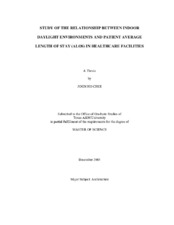| dc.description.abstract | This study investigates how indoor daylight environments affect patient Average
Length of Stay (ALOS), by evaluating and analyzing daylight levels in patient rooms in
comparison to their ALOS. The patient ALOS data were taken at one general hospital in
Inchon, Korea and the other in Bryan, Texas, U.S.A.; physical, environmental and
daylighting conditions were assessed at each building site. The gathered data were
analyzed using SPSS statistical package to determine the trends in patients’ length of
stay in hospital wards with 95% and 90% statistical significances. The data were
categorized based on the orientation of a patient room and were compared between
different orientations and types of patient rooms in the same ward of each hospital.
Selected hospital wards were classified based on their orientations and types of
patient rooms. The other variables considered in the study were: the differences in
daylighting environments (illuminance, luminance ration, daylight factor, diversity and
uniformity of illuminance), and physical environment properties of the patient rooms of each hospital, and how these affected patient ALOS in both locations (Inchon and Bryan).
To analyze the daylighting environment, on-site measurements, RADIANCE simulations
and physical scale model measurements were conducted. This study also investigated
patients’ feelings and opinions, and their preferences in daylighting environments with
the questionnaire survey.
Through this study, three hypotheses were tested and was evidence for the
following conclusions.
First, there may be a positive relationship between indoor daylight environments
and ALOS. Second, seasonal weather differences cause different indoor daylighting
levels and may influence the length of patient hospitalization. Third, overall patient
satisfaction and reactions to patient rooms may be related with indoor daylight
environments. More controllable shading devices, naturally lighted indoor environments,
and glare prevention create positive outcomes for patient ALOS and visual comfort.
To increase the validity and confidence about the positive effects of daylight on
human physiological conditions, further studies are necessary which provide more
samples, facilities and other variables.
This study was created as a basis for the development of recommendations for
designing patient rooms in healthcare facilities and, as a result, should be used to achieve
more effective healing environments. | en |


